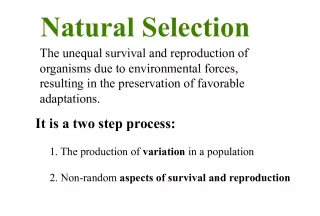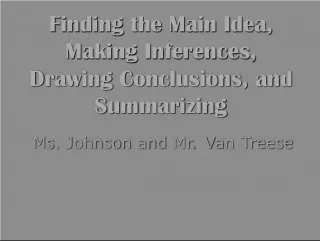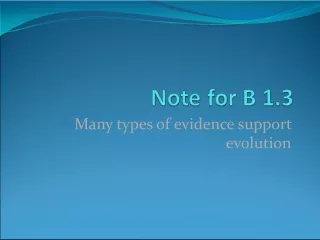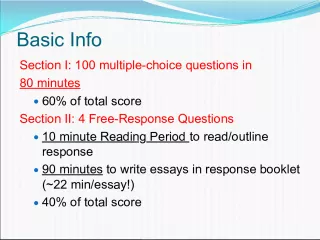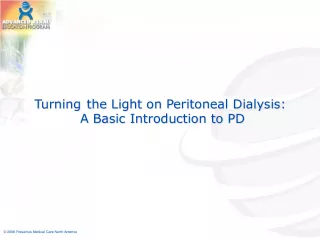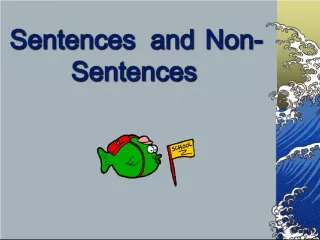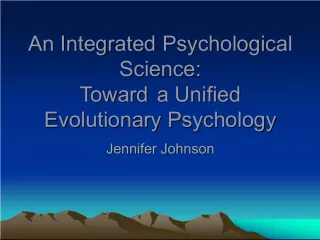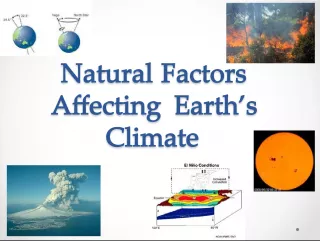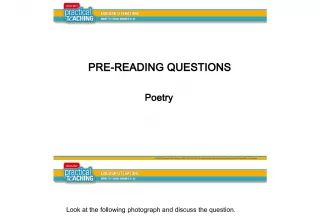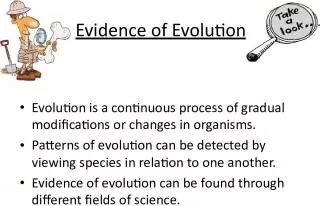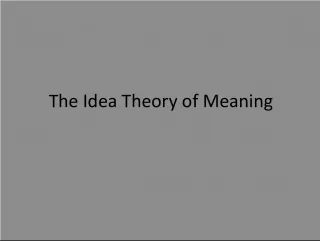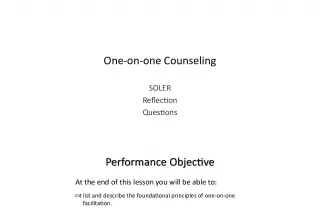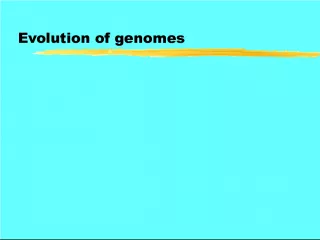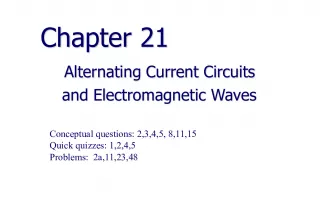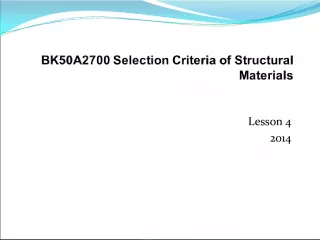Understanding Evolution through Natural Selection: The Big Idea Questions
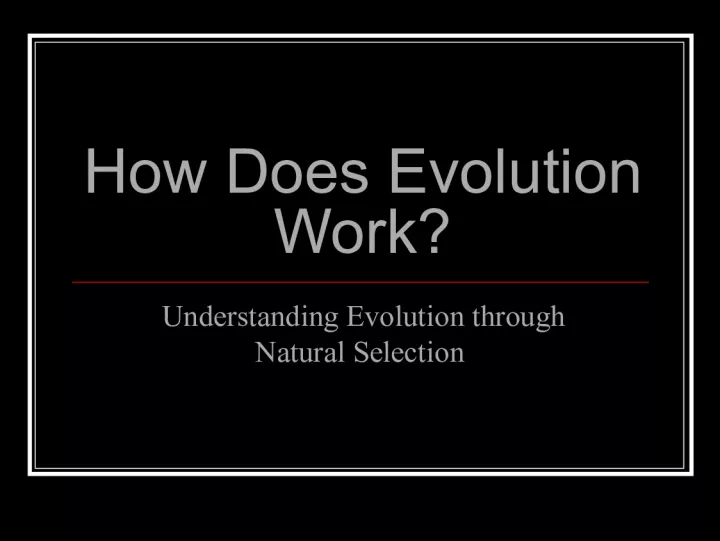

This article delves into the fundamental concept of evolution through natural selection. It explores the history and development of the theory of evolution, including the work of Charles Darwin. The importance
- Uploaded on | 3 Views
-
 meganparker
meganparker
About Understanding Evolution through Natural Selection: The Big Idea Questions
PowerPoint presentation about 'Understanding Evolution through Natural Selection: The Big Idea Questions'. This presentation describes the topic on This article delves into the fundamental concept of evolution through natural selection. It explores the history and development of the theory of evolution, including the work of Charles Darwin. The importance. The key topics included in this slideshow are . Download this presentation absolutely free.
Presentation Transcript
Slide1How Does EvolutionWork? Understanding Evolution through Natural Selection
Slide2Evolution Big idea Questions Describe what is meant by evolution through natural selection. Describe the development of the theory of evolution by natural selection. Include mention of Charles Darwin. Identify the importance of variation within a population for the long-term survival of the species. Explain what is meant by being “fit” from an evolutionary standpoint. What support do scientists offer for the theory of evolution by natural selection? Include mention of fossils and genetics.
Slide3Charles Darwin Known as the “father of evolution” because he proposed the idea of evolution through natural selection . Most biologists today agree that Darwin’s theory was “the single best idea that anyone has ever had.” Think about why… Here is a clip from the series “The 100 Greatest Discoveries in Science.” This theory was named THE #1 discovery of all time. If the link doesn’t work, please use the one on the wiki, Clip #1.
Slide4Evolution through NaturalSelection Let’s look at Darwin and his theory a bit closer… As you watch, please use the clip to answer some of the big idea questions. Here is a bit of background on Darwin and his theory. If this link doesn’t work, please use Clip #2 from the wiki.
Slide5Evolution through NaturalSelection Definition of natural selection: • The process by which individuals that are better adapted to their environment are more likely to survive and reproduce than other members of the same species. • This is thought to be the reason for evolution, or changes to a species over time. • Also referred to as “survival of the fittest.”
Slide6Example of natural selection This simulation illustrates how environmental change affects the process of natural selection. In this game, you control the amount of pollution produced by a nearby factory. Notice how this environmental factor influences the bugs that live in the bushes nearby. Click here for the interactive site. If this link doesn’t work, please go to the wiki and use that link. Then, go to the video clip that explains this concept in a different organism, a mouse. Click here for the clip . If this link doesn’t work, go to the wiki and select the link called, Mouse Clip Next, watch one of the most common examples of natural selection, the peppered moth – Click here to view . If it doesn’t work, go back to the wiki and select the Peppered Moth Clip.
Slide7Evolution through NaturalSelection Theodosius Dobzhansky wrote in the magazine American Biology Teacher (1973), “Nothing in biology makes sense except in the light of evolution.” The theory of evolution by natural selection is significant because it pulled together observations from several different areas of science: - biology & genetics - geology (rocks) & paleontology (fossils) * We will discuss evidence later this week!
Slide8Evolution through NaturalSelection Darwin’s theory was also one of the first written under the modern, accepted mind-set of a theory: it was written to be provisional. When Darwin authored On the Origin of Species , he assumed that his ideas would need to be altered to fit with other observations. However, it hasn’t been altered. In fact, more and more evidence to support his ideas has accumulated.
Slide9Natural Selection Evolution refers to the changes that occur over long periods of time in the characteristics and diversity of organisms. Evolution is a process that happens over long periods of time. Darwin proposed that this is due to natural selection .
Slide10Natural Selection The theory of evolution through natural selection is based on the fact that variation exists in a population. Individuals that are better adapted to living in a particular environment will have an increased chance to survive and reproduce .
Slide11Reproduction & NaturalSelection: Connecting Dots Reproduction can come in two forms: asexual and sexual. Mutations (along with the blending of genes through sexual reproduction) leads to variety among individuals in a population. If an organism’s traits don’t match the environment, it could lead to extinction for the species. If the adaptations are beneficial, the species will survive.
Slide12Clip, “How does evolutionreally Work?” While watching this video clip, you will see how scientists have continued Darwin’s work to explore the idea of evolution through natural selection. As you watch, please think about how you might answer the big idea questions posed to you. How Does Evolution Really Work? This is clip #3 on the wiki if this link doesn’t work.
Slide13Natural Selection Individual organisms can not change their characteristics in order to adapt, unless they learn new traits . Evolution refers to the change that a species undergoes over time. Fossils are the key to our understanding of these changes over the history of life on Earth. We also have made advances in genetics that supports the theory.
Slide14Since Darwin Evidence continues to accumulate to support Darwin’s theory of evolution through natural selection. We will be examining two significant “chunks” of scientific discoveries that support the theory of evolution through natural selection. This will be in the areas of genetics & fossils . This will be specifically addressed in class later this week.
Slide15Clip, “Isn’t Evolution ‘Just aTheory?’” • While watching this video clip, please think about addressing the big idea questions posed to you. • Isn’t Evolution ‘Just a Theory?’” Use Clip #4 from the wiki if this link doesn’t play the video clip.
Slide16Pulling it all together• Hopefully you now see how reproduction (both sexual and asexual) is necessary for a species to survive. • In order to increase the species’ chance of survival, variety among individuals is beneficial. Variety can come from mutations in both sexual & asexual reproducers; sexual reproduction offers variety in the species in a different way from asexual reproduction. • When variety exists, natural selection can occur, which can change the adaptations within the species. • Based on the enviornment, these adaptations can lead to the evolution of the species.
Slide17Pulling it all together• Here’s another teacher’s explanation of all of these pieces put together…. Click here to have it explained . Or, if it deosn’t work, you can click on Clip #5 from the wiki, How Does Variety Give Rise to New Species. • You could also watch the Khan Academy explanation of this process if that would be helpful – click here for that clip . Or, go back to the wiki and find it above the list of clips we’ve been using for this lesson.
Slide18Next Steps• When you have reached this point, you should have information about many of the big idea questions on evolution. We will get the rest in the upcoming days. • In the meantime, you have two choices for the remainder of the period: (1) Start your frog comic – I will explain this to everyone if you don’t understand… yet (2) Work on the Adaptations Chart we started last week.
